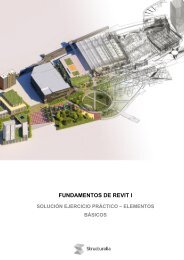LAD01154_IntegrationRenewableEnergyBuildings_CP
Create successful ePaper yourself
Turn your PDF publications into a flip-book with our unique Google optimized e-Paper software.
INTEGRATION OF RENEWABLE ENERGIES<br />
PRACITICAL EXERCISE. BIOMASS
Integration of renewable energies – Practical exercise. Biomass<br />
© Structuralia 2
Integration of renewable energies – Practical exercise. Biomass<br />
ÍNDICE<br />
ÍNDICE ...............................................................................................................................................................................................3<br />
1. SESIÓN 1 ..................................................................................................................¡ERROR! MARCADOR NO DEFINIDO.<br />
1.1 Título 2 ................................................................................................................................¡Error! Marcador no definido.<br />
2. SESIÓN 2 ..................................................................................................................¡ERROR! MARCADOR NO DEFINIDO.<br />
3. REFERENCIAS........................................................................................................¡ERROR! MARCADOR NO DEFINIDO.<br />
3 © Structuralia
Integration of renewable energies – Practical exercise. Biomass<br />
1. DEFINITION<br />
Consider the following data from an existing 400 kW centralized heating installation in Madrid,<br />
Spain, equipped with a central boiler that produces heat for heating and production of domestic<br />
hot water powered by diesel fuel:<br />
• 280-houses building<br />
• Area of the houses 85m2 (approx. 23.800m2 heated)<br />
• Year of construction: 1970<br />
• Fuel:<br />
• Annual consumption 250,000 L (diesel C)<br />
• Diesel price: 0,763 euros/L<br />
• Boiler room equipped with:<br />
• (2) 930kW boilers<br />
• (3) DHW preparation and accumulation deposits of 1500L each.<br />
The change from fuel to Biomass is studied.<br />
Consumption data obtained from consumption history are presented in the table.<br />
Diesel 250.000 L/year<br />
LCV 10,5 kWh/L<br />
Energy 2625 MWh/year<br />
Surface 23.800 m 2<br />
Specific energy 110 kWh/m 2 /year<br />
The power data corresponding to the two boilers results in total of the building:<br />
© Structuralia 4
Integration of renewable energies – Practical exercise. Biomass<br />
Boilers 2 ud<br />
Unit power 930 kW<br />
Total power 1860 kW<br />
Surface 23.800 m 2<br />
Specific power 78 W/m 2<br />
The average seasonal performance of the boilers is 51% and the consumption rate of DHW<br />
versus the total is 27%.<br />
Use the same seasonal average performance for the biomass boiler(s): 51%<br />
Consider the monthly distribution of DHW and heating consumptions shown in the table:<br />
MWh/year<br />
ACS CALEF Total<br />
January 47 515 562<br />
February 47 515 562<br />
March 47 343 390<br />
April 47 172 219<br />
May 47 0 47<br />
June 47 0 47<br />
July 47 0 47<br />
August 47 0 47<br />
September 47 0 47<br />
5 © Structuralia
Integration of renewable energies – Practical exercise. Biomass<br />
October 47 0 47<br />
November 47 172 219<br />
December 47 343 390<br />
566 2059 2625<br />
The area has a guaranteed distribution of the following fuels:<br />
• Pellet<br />
• Wood splinter (oak: Quecus Pirenaica)<br />
• Olive bone<br />
For this project, due to the relatively high annual consumption (for a residential building) the<br />
following fuel is chosen:<br />
• Splinter G50<br />
• LCV: 4 kWh/kg<br />
• Price: 80 €/Ton<br />
• Apparent density: 300 kg/m3<br />
The splinter is much cheaper than the pellet (about 140€/Ton). Olive bone could be considered<br />
as an alternative, with an apparent density of 550 kg/m3 and a Calorific Value of 4.2 kWh/kg and<br />
a pump price to splinter.<br />
© Structuralia 6
Integration of renewable energies – Practical exercise. Biomass<br />
The budget for the rehabilitation work is as follows:<br />
Amount (€)<br />
1 CIVIL WORK AND DISASSEMBLY 60.000,00 €<br />
2 GENERATORS AND EQUIPMENT 330.000,00 €<br />
3 PIPES AND ACCESSORIES 50.000,00 €<br />
4 VENTILATION AND CHIMNEYS 150.000,00 €<br />
5 SAFETY 2.000,00 €<br />
6 ELECTRICITY 12.000,00 €<br />
7 CONTROL SYSTEM AND TEL 10.000,00 €<br />
8 LEGALIZATION AND COMMISSIONING 9.000,00 €<br />
Implementation budget 623.000,00 €<br />
Assuming that diesel boilers should be replaced as obsolete, only the additional value of the<br />
biomass installation would have to be considered. In this case, it would be part of the civil works<br />
(50% of 60.000€=30.000€) and the additional value of the boilers (50% of 330.000€=165.000€),<br />
therefore we would have 195.000€.<br />
Considering a 10-year credit with an interest of 5% an annual payment of 24,050 euros would be<br />
obtained for additional depreciation of facilities.<br />
Maintenance is proportional to the value of the equipment. We consider 3% of the additional value<br />
(3% of 195.000€) the additional expense to the maintenance of the biomass installations, so we<br />
would have 5.850€, therefore, we would have a total of differential costs of 24.050€ +<br />
5.850€=29.900€.<br />
Determine:<br />
1.- The space required for biomass storage.<br />
2.- Comments on transport and supply<br />
3.- Calculate the savings represented by the installation the first year of installation of the biomass<br />
boiler compared to the option of reinstalling new diesel boilers. Consider in this case a 74% return<br />
on both installations.<br />
7 © Structuralia


















